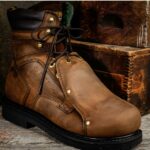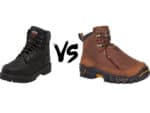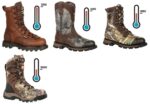Logger boots and steel toes are designed for the safety of the wearer but each in its way. Logger boots, as it appears from the name, are mostly used by loggers.
Whereas other workers with different working requirements have other types of boots. Typically, loggers, farmers, and ranchers use logging boots. On the other hand, workers in construction fields use construction boots with steel toes.
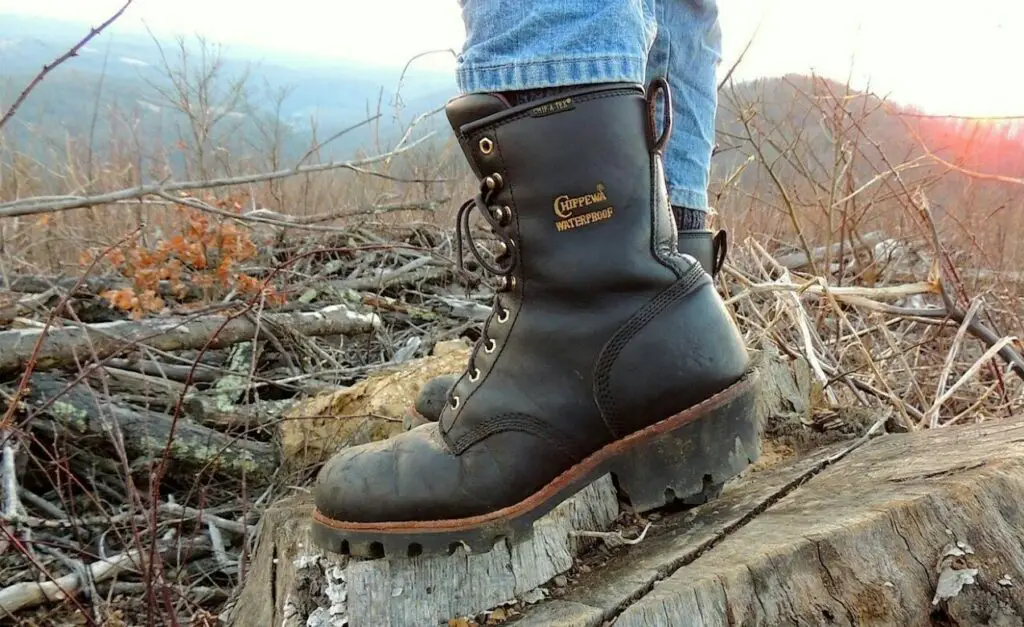 Logger boots don’t have steel toes because steel toes have their pros and cons. Whilst they protect the toes from impacts, they are heavy on the feet. So, they are not as practical as people might think. As for loggers, they don’t need such protection nor do they need heavy boots. So, it is better not to include them in their boots.
Logger boots don’t have steel toes because steel toes have their pros and cons. Whilst they protect the toes from impacts, they are heavy on the feet. So, they are not as practical as people might think. As for loggers, they don’t need such protection nor do they need heavy boots. So, it is better not to include them in their boots.
Although you might find logger boots with steel toes, these are not popular as those without. Each type of boots with its safety measures is designed for a certain purpose. Therefore, according to your profession, you should be able to pick the right boots. However, you might think that steel toes are an extra protective layer. So, loggers should wear boots with this protection.
Yet, to better understand this issue, you should first know what logger boots are. Also, the steel toes and how people use them in their boots. After that, you will know the advantages and disadvantages of boots with steel toes. Further, you will be able to decide if you would go for logger boots with or without steel toes.
| Logger boots with steel toes | Logger boots without steel toes | |
| Pros | Protection to the toes | More flexibility and comfort, Can be repaired easily |
| Cons | Heavyweight, Heat conductivity | No toes protection |
Logger Boots: What Are They Used For?
Logger boots are a kind of boots that was made specifically for loggers. They are similar to construction boots in many things. However, some features are emphasized more in logger boots as per the profession’s requirements. Similarly, other features are more important to construction boots than logger ones.
The two major distinctions between logger boots and other kinds of boots are high heels and high neck. Logger boots are usually 8 inches or more, higher than normal working or safety boots. Also, they have raised heels that work well with climbing spurs.
Another feature is the waterproof one. This is one of the most important protective features of logger boots. Loggers work in wet areas with lots of bush and mud. Thus, they need to keep their feet dry and protect them from any bacteria in the water
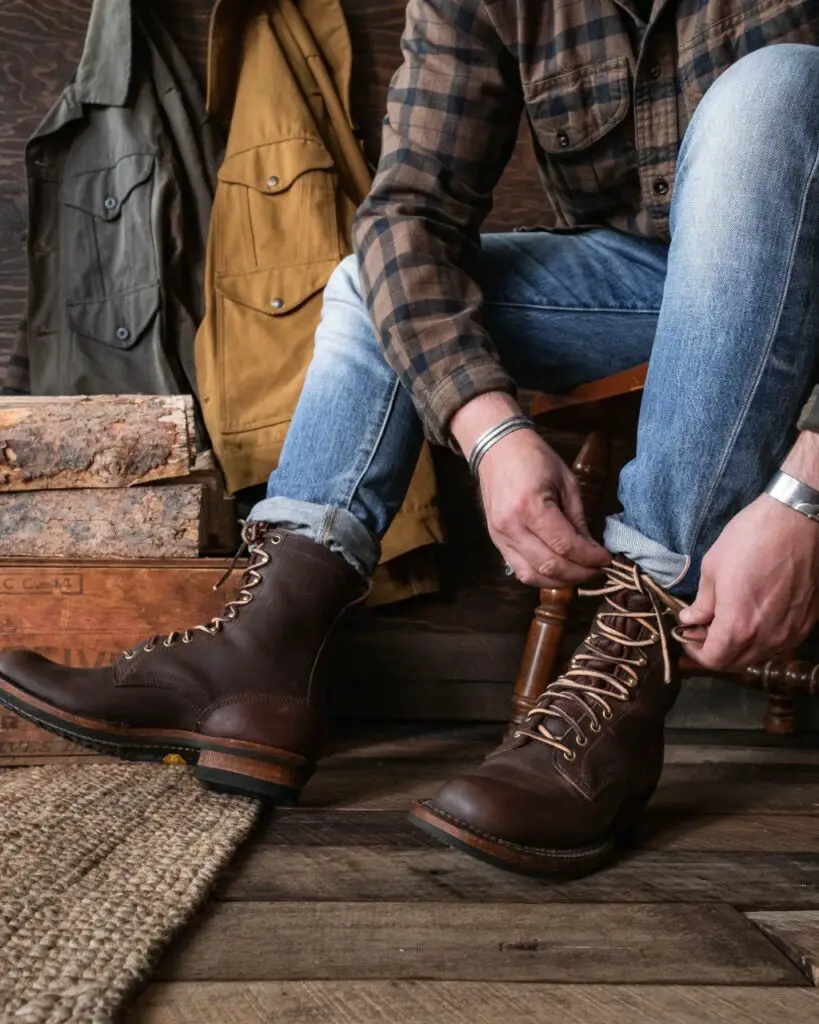 Although these boots were initially designed for loggers, other professions now use them. For example, farmers and ranchers work on damp grounds. Also, they use them as the high heels are suitable for horse riding and won’t slip.
Although these boots were initially designed for loggers, other professions now use them. For example, farmers and ranchers work on damp grounds. Also, they use them as the high heels are suitable for horse riding and won’t slip.
On the other side, other working boots are generally designed for comfort and safety. Depending on the specific job these boots are for, the features will differ. For example, construction boots have steel toes for safety. They are also heavy-duty to withstand tough working conditions.
Some brands offer logger boots with steel toes. This way, they are providing positive features like waterproofing and high heels of logger boots. Besides, you have the protection of steel toes.
To better decide if you need logger boots with or without steel toes or search for other kinds of boots, check the advantages and disadvantages of each.
See also: Are logger boots comfortable to wear all-day
Pros and Cons of Logger Boots with Steel Toes
Steel toes are round metal pieces that cover the toes. They are tough steel parts placed underneath the upper leather part of the
boots. The importance of steel toes is to protect the toes as much as possible against impacts.
Steel toes are not a new concept to working boots in general. Workers have been using these boots for a long time ago. Furthermore, there are special boots with only steel toes as the main protective feature for the whole boots.
Extra protection
Although loggers don’t deal with heavy machinery as workers in construction fields, logs and tree branches are also heavy. Thus, loggers might be subjected to incidents as logs falling on their feet and hurting their toes. Logger boots with steel toes will be very beneficial here for preventing such accidents.
On the other side, logger boots with steel toes have two cons. These are:
Heavyweight
Steel toes are not the most comfortable thing to wear. They can add much weight to the boots. Because of the heavyweight, there are not easy to move and climb with. Loggers and farmers certainly need something flexible to climb trees and ride horses easily
Heat conductivity
Steel toes, since they are metal, conduct heat and cold. Therefore, if you work on wet grounds in hot or cold weather, you will feel the temperature in your feet. For loggers and farmers, mostly work on wet grounds. Further, they work in open-air places where the sun can heat their feet.
Pros and Cons of Logger Boots without Steel Toes
Likewise, logger boots without steel toes have pros and cons. These are the opposite of those with steel toes. As for the pros, it includes:
Flexibility and comfort
Logger boots without steel toes are lighter in weight. Further, they are more flexible from this front part around the toes. So, loggers can bend and flatten their toes freely inside the boots.
This will give them more convenience while doing their job. Also, those who will need to climb trees and ride horses need this flexibility. Steel toes can hinder their job instead of aiding them.
Easier repairing
If you usually wear boots for work, you know that the boots can wear out at some point. When you logger boots without steel toes, it is easier to repair them. Simply, repairing those boots is exactly similar to repairing any kinds of boots as they don’t have an extra piece inside.
However, we are not saying that logger boots with steel toes cannot be repaired. Yet, they are much difficult to repair.
Whereas the con to not having steel toes for these boots is:
Losing protection of the toes
If unfortunately, you had an accident like something dropped over your feet, your toes will get injured. Yet, as mentioned above, this is not likely to happen for loggers and farmers. So, weighing the pros and cons of logger boots without steel toes, the pros will overweight.
See also: Comparison between lineman and logger boots
Conclusion
As you can see, steel toes are more of a protective feature against impacts. On the other side, they have negative effects as heat conductivity and weight. For logger boots, all they need is protection against wet and mud. Thus, logger boots don’t need those steel toes.
On the other side, workers in construction fields need such protection. In this industry, workers use heavy machinery and metal objects. Thus, they are more subjected to incidents as objects falling on their feet or heavy metals hitting their toes. So, boots with steel toes are a great option to consider if you are working in such an industry.
To sum up, choosing your working boots is something you should do yourself. You know your job more than anybody else. So, accordingly, you can choose the features you are in most of need of.



